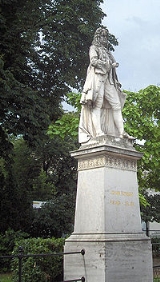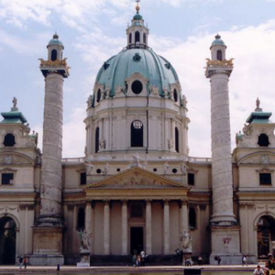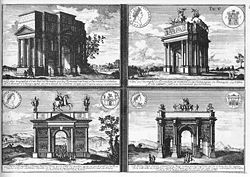
Johann Bernhard Fischer von Erlach
Encyclopedia

Johann Bernhard Fischer von Erlach, born Johann Bernhard Fischer (20 July 1656 – 5 April 1723) was probably the most influential Austrian architect
Architecture
Architecture is both the process and product of planning, designing and construction. Architectural works, in the material form of buildings, are often perceived as cultural and political symbols and as works of art...
of the Baroque
Baroque architecture
Baroque architecture is a term used to describe the building style of the Baroque era, begun in late sixteenth century Italy, that took the Roman vocabulary of Renaissance architecture and used it in a new rhetorical and theatrical fashion, often to express the triumph of the Catholic Church and...
period.
Architectural tastes throughout the Habsburg Empire
Habsburg Monarchy
The Habsburg Monarchy covered the territories ruled by the junior Austrian branch of the House of Habsburg , and then by the successor House of Habsburg-Lorraine , between 1526 and 1867/1918. The Imperial capital was Vienna, except from 1583 to 1611, when it was moved to Prague...
were profoundly influenced by his ideas, as articulated in A Plan of Civil and Historical Architecture (1721), one of the first and most popular comparative studies of world architecture.

Early life in Italy
Born near GrazGraz
The more recent population figures do not give the whole picture as only people with principal residence status are counted and people with secondary residence status are not. Most of the people with secondary residence status in Graz are students...
, Johann Fischer was trained in the workshop of his father, a provincial artisan, before departing for Rome at the precocious age of 16. He spent the following sixteen years in Italy
History of Italy during foreign domination and the unification
The history of Italy in the Early Modern period was partially characterized by foreign domination:Following the Italian Wars , Italy saw a long period of relative peace, first under Habsburg Spain and then under Habsburg Austria . During the Napoleonic era, Italy was a client state of the French...
. In Rome he joined the workshop of his fellow Austrian Johann Paul Schor
Johann Paul Schor
Johann Paul Schor , known in Rome as "Giovanni Paolo Tedesco" , was an Austrian artist. He was the preeminent designer of decorative arts in Baroque Rome, providing drawings for state beds, fireworks, coaches, silver, textiles and even banquet setpieces executed in sugar...
and of the great Bernini
Gian Lorenzo Bernini
Gian Lorenzo Bernini was an Italian artist who worked principally in Rome. He was the leading sculptor of his age and also a prominent architect...
, who gave him ample opportunities to study both ancient and modern sculpture
Sculpture
Sculpture is three-dimensional artwork created by shaping or combining hard materials—typically stone such as marble—or metal, glass, or wood. Softer materials can also be used, such as clay, textiles, plastics, polymers and softer metals...
and architecture. He then moved to Naples
Naples
Naples is a city in Southern Italy, situated on the country's west coast by the Gulf of Naples. Lying between two notable volcanic regions, Mount Vesuvius and the Phlegraean Fields, it is the capital of the region of Campania and of the province of Naples...
, where he was reported to have amassed a considerable fortune serving the Spanish viceroy.
Back in Austria in 1687, Fischer von Erlach was installed as a fashionable and sought-after architect. Commissions were plentiful, as royalty and highest echelons of aristocracy sought to repair damage inflicted on their country residences by the Ottoman Turks
Ottoman Turks
The Ottoman Turks were the Turkish-speaking population of the Ottoman Empire who formed the base of the state's military and ruling classes. Reliable information about the early history of Ottoman Turks is scarce, but they take their Turkish name, Osmanlı , from the house of Osman I The Ottoman...
in the course of their 1683 campaign
Battle of Vienna
The Battle of Vienna took place on 11 and 12 September 1683 after Vienna had been besieged by the Ottoman Empire for two months...
. Fischer's understanding of an urbane Baroque idiom appeared superior to that prevalent in Central Europe
Central Europe
Central Europe or alternatively Middle Europe is a region of the European continent lying between the variously defined areas of Eastern and Western Europe...
, and in 1687 he secured the key position of court architect, which he would retain in the service of three emperors
Holy Roman Emperor
The Holy Roman Emperor is a term used by historians to denote a medieval ruler who, as German King, had also received the title of "Emperor of the Romans" from the Pope...
.


Service under Joseph I
During the 1690s, which have been described as the most fruitful period of Fischer's career, he adapted the Italian Baroque to local needs and traditions. In 1690, he won great acclaim for two temporary triumphal archTriumphal arch
A triumphal arch is a monumental structure in the shape of an archway with one or more arched passageways, often designed to span a road. In its simplest form a triumphal arch consists of two massive piers connected by an arch, crowned with a flat entablature or attic on which a statue might be...
es constructed in Vienna
Vienna
Vienna is the capital and largest city of the Republic of Austria and one of the nine states of Austria. Vienna is Austria's primary city, with a population of about 1.723 million , and is by far the largest city in Austria, as well as its cultural, economic, and political centre...
to celebrate Joseph I
Joseph I, Holy Roman Emperor
Joseph I , Holy Roman Emperor, King of Bohemia, King of Hungary, King of the Romans was the elder son of Emperor Leopold I and his third wife, Eleonor Magdalene of Neuburg....
's coronation. He later personally instructed Joseph in architectural arts, so successfully that in 1696 the monarch elevated Johann Fischer to the nobility, as Johann Bernhard Fischer von Erlach.
In his 17th-century designs and commissions, Fischer von Erlach embraced Berniniesque powerful curving lines, seeking to convey a sense of movement. His other inspirations included Mansart
François Mansart
François Mansart was a French architect credited with introducing classicism into Baroque architecture of France...
's country residences
Château
A château is a manor house or residence of the lord of the manor or a country house of nobility or gentry, with or without fortifications, originally—and still most frequently—in French-speaking regions...
and the Palladian
Palladian architecture
Palladian architecture is a European style of architecture derived from the designs of the Venetian architect Andrea Palladio . The term "Palladian" normally refers to buildings in a style inspired by Palladio's own work; that which is recognised as Palladian architecture today is an evolution of...
classical villa
Villa
A villa was originally an ancient Roman upper-class country house. Since its origins in the Roman villa, the idea and function of a villa have evolved considerably. After the fall of the Roman Republic, villas became small farming compounds, which were increasingly fortified in Late Antiquity,...
s, which he would study during his journeys to Prussia
Prussia
Prussia was a German kingdom and historic state originating out of the Duchy of Prussia and the Margraviate of Brandenburg. For centuries, the House of Hohenzollern ruled Prussia, successfully expanding its size by way of an unusually well-organized and effective army. Prussia shaped the history...
, the Netherlands, England in 1704 and Venice
Venice
Venice is a city in northern Italy which is renowned for the beauty of its setting, its architecture and its artworks. It is the capital of the Veneto region...
in 1707.
Thus Fischer presided over the genesis and early evolution of a distinctive brand of Baroque architecture, which would shape architectural tastes of the Austrian aristocracy for decades to come. His emblematic design from the 1690s was the Winter Palace of Prince Eugene of Savoy
Prince Eugene of Savoy
Prince Eugene of Savoy , was one of the most successful military commanders in modern European history, rising to the highest offices of state at the Imperial court in Vienna. Born in Paris to aristocratic Italian parents, Eugene grew up around the French court of King Louis XIV...
, commenced in 1695 in Vienna. As Hans Aurenhammer put it, this edifice represented "a new type of town palace characterized by impressive form, structural clarity, and the dynamic tension of its decoration".
Salzburg and late works
Fischer's expertise in town planning made itself felt in designs he executed for the Archbishop of Salzburg. Particularly accomplished are two churches, the Dreifaltigkeitskirche (1694–1702) and the (1696–1707), whose highly pitched domeDome
A dome is a structural element of architecture that resembles the hollow upper half of a sphere. Dome structures made of various materials have a long architectural lineage extending into prehistory....
s and towers, convex facade
Facade
A facade or façade is generally one exterior side of a building, usually, but not always, the front. The word comes from the French language, literally meaning "frontage" or "face"....
s, and dynamic forms irrevocably changed the outline of Salzburg
Salzburg
-Population development:In 1935, the population significantly increased when Salzburg absorbed adjacent municipalities. After World War II, numerous refugees found a new home in the city. New residential space was created for American soldiers of the postwar Occupation, and could be used for...
. They say that masses of stone were designed by Fischer so as to give the appearance of billows of cloud and smoke. The archbishop's country seat, Schloss Klessheim
Schloss Klessheim
Schloss Klessheim is a Baroque palace situated west of Salzburg in the Austrian commune of Wals-Siezenheim. A former summer residence of the Archbishops of Salzburg, it is now used by Salzburg Casino.-History:...
(1700–09), was also designed by him.

Dalmatia
Dalmatia is a historical region on the eastern coast of the Adriatic Sea. It stretches from the island of Rab in the northwest to the Bay of Kotor in the southeast. The hinterland, the Dalmatian Zagora, ranges from fifty kilometers in width in the north to just a few kilometers in the south....
brought back to Western Europe the influence of the classical Diocletian's Palace
Diocletian's Palace
Diocletian's Palace is a building in Split, Croatia, that was built by the Roman emperor Diocletian at the turn of the fourth century AD.Diocletian built the massive palace in preparation for his retirement on 1 May 305 AD. It lies in a bay on the south side of a short peninsula running out from...
and provided Europe with one of the first professional architectural glimpses of this notable Roman monument.
After Joseph I's death in 1711, Fischer von Erlach was rarely entrusted with new commissions, as the more pleasing and less demanding designs of his rival Johann Lucas von Hildebrandt proved more popular with the young monarch Charles VI, Holy Roman Emperor
Charles VI, Holy Roman Emperor
Charles VI was the penultimate Habsburg sovereign of the Habsburg Empire. He succeeded his elder brother, Joseph I, as Holy Roman Emperor, King of Bohemia , Hungary and Croatia , Archduke of Austria, etc., in 1711...
and his court. He found an opportunity to draw some of the finest architectural reconstructions of the buildings of Antiquity, which were published in his groundbreaking Plan of Civil and Historical Architecture in 1721. He was also made responsible for various administrative tasks, which would take a large portion of his energy and time.
Clam-Gallas Palace in Prague
Prague
Prague is the capital and largest city of the Czech Republic. Situated in the north-west of the country on the Vltava river, the city is home to about 1.3 million people, while its metropolitan area is estimated to have a population of over 2.3 million...
, commenced in 1713, was one of his last designs for a stately town residence. The structure, much imitated by later architects, highlights Fischer's enthusiasm for Palladian facades, which became ever more pronounced during the last period of his work.
But it is Karlskirche
Karlskirche
The St. Charles's Church is a church situated on the south side of Karlsplatz, Vienna. It is located on the edge of the 1st district, 200 metres outside the Ringstraße...
in Vienna, started in 1715, that most fully illustrates his late synthetic style. In this structure, completed by his son Joseph Emanuel
Joseph Emanuel Fischer von Erlach
Joseph Emanuel Fischer von Erlach, also Fischer von Erlach the younger was an Austrianarchitect of the baroque, Rococo and baroque classicism.-Life and career:...
, Fischer's ambition was to harmonize the principal elements and ideas that underlie the most significant churches in the history of Western architecture: the Temple of Solomon in Jerusalem, Hagia Sophia
Hagia Sophia
Hagia Sophia is a former Orthodox patriarchal basilica, later a mosque, and now a museum in Istanbul, Turkey...
in Constantinople
Constantinople
Constantinople was the capital of the Roman, Eastern Roman, Byzantine, Latin, and Ottoman Empires. Throughout most of the Middle Ages, Constantinople was Europe's largest and wealthiest city.-Names:...
, the Pantheon
Pantheon, Rome
The Pantheon ,Rarely Pantheum. This appears in Pliny's Natural History in describing this edifice: Agrippae Pantheum decoravit Diogenes Atheniensis; in columnis templi eius Caryatides probantur inter pauca operum, sicut in fastigio posita signa, sed propter altitudinem loci minus celebrata.from ,...
and Saint Peter's Basilica in Rome, the Dome des Invalides in Paris and Saint Paul's Cathedral in London.
Selected works
- Schönbrunn PalaceSchönbrunn PalaceSchönbrunn Palace is a former imperial 1,441-room Rococo summer residence in Vienna, Austria. One of the most important cultural monuments in the country, since the 1960s it has been one of the major tourist attractions in Vienna...
, Vienna - KarlskircheKarlskircheThe St. Charles's Church is a church situated on the south side of Karlsplatz, Vienna. It is located on the edge of the 1st district, 200 metres outside the Ringstraße...
, Vienna (1715— ) - Mausoleum of Ferdinand II, Graz
- Parnas Fountain, BrnoBrnoBrno by population and area is the second largest city in the Czech Republic, the largest Moravian city, and the historical capital city of the Margraviate of Moravia. Brno is the administrative centre of the South Moravian Region where it forms a separate district Brno-City District...
- Church of the Trinity, Salzburg
- University Church, Salzburg
- Clam-Gallas Palace, PraguePraguePrague is the capital and largest city of the Czech Republic. Situated in the north-west of the country on the Vltava river, the city is home to about 1.3 million people, while its metropolitan area is estimated to have a population of over 2.3 million...
- Spanish Riding SchoolSpanish Riding SchoolThe Spanish Riding School of Vienna, Austria, is a traditional riding school for Lipizzan horses, which perform in the Winter Riding School in the Hofburg...
, ViennaViennaVienna is the capital and largest city of the Republic of Austria and one of the nine states of Austria. Vienna is Austria's primary city, with a population of about 1.723 million , and is by far the largest city in Austria, as well as its cultural, economic, and political centre... - Electoral chapel in Cathedral, Wrocław

